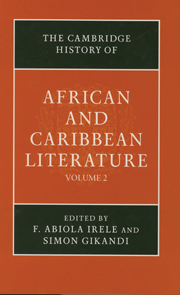Book contents
- Frontmatter
- 23 East African literature in English
- 24 Anglophone literature of Central Africa
- 25 West African literature in English: beginnings to the mid-seventies
- 26 South African literature in English
- 27 African literature in French: sub-Saharan Africa during the colonial period
- 28 North African literature in French
- 29 Francophone literatures of the Indian Ocean
- 30 African literature in Spanish
- 31 African literature in Portuguese
- 32 Popular literature in Africa
- 33 Caribbean literature in French: origins and development
- 34 Caribbean literature in Spanish
- 35 Anglophone Caribbean literature
- 36 The Harlem Renaissance and the Negritude movement
- 37 Postcolonial Caribbean identities
- 38 African literature and post-independence disillusionment
- 39 “Postcolonial” African and Caribbean literature
- 40 Modernism and Postmodernism in African literature
- Index
- References
36 - The Harlem Renaissance and the Negritude movement
Published online by Cambridge University Press: 28 March 2008
- Frontmatter
- 23 East African literature in English
- 24 Anglophone literature of Central Africa
- 25 West African literature in English: beginnings to the mid-seventies
- 26 South African literature in English
- 27 African literature in French: sub-Saharan Africa during the colonial period
- 28 North African literature in French
- 29 Francophone literatures of the Indian Ocean
- 30 African literature in Spanish
- 31 African literature in Portuguese
- 32 Popular literature in Africa
- 33 Caribbean literature in French: origins and development
- 34 Caribbean literature in Spanish
- 35 Anglophone Caribbean literature
- 36 The Harlem Renaissance and the Negritude movement
- 37 Postcolonial Caribbean identities
- 38 African literature and post-independence disillusionment
- 39 “Postcolonial” African and Caribbean literature
- 40 Modernism and Postmodernism in African literature
- Index
- References
Summary
One of the most significant elements of social, intellectual, and cultural movements among black people has been the progressive development of the idea of Africa as an inspirational concept of collective affirmation and endeavor in the modern world. This concept, proceeding from a comprehensive vision of African peoples, societies, and cultures as constituting an all-encompassing entity, served as a model of thought and action that gave force and direction to pan-Africanism as well as to the local manifestations of nationalism in Africa that derived ideas and impulses from the global consciousness of race implied in the pan-African idea itself. The historical connection between pan-Africanism and African nationalism is evident at the ideological and political level of their expressions; there is an obvious sense in which the former laid the foundation of ideas for the latter (Bakpetu Thompson 1972; Esedebe 1994). But it is in the literature that the atmosphere of feelings, the deep affective responses to the conditions of existence that determine the processes by which these ideas were articulated, came to be fully conveyed.
The rooted connection between the various forms of black affirmation in the modern world is exemplified, in an arresting way, by the historical and thematic links between the Harlem Renaissance and the Negritude movement, forming a defined current within the cycle of responses through which black writers and intellectuals on both sides of the Atlantic have related to each other within the black world and to the vicissitudes of a common historical experience. But before examining the specific nature of these links, it is essential to consider the historical and sociological background that determined the context of black expression in the twentieth century, a context in which the idea of Africa has featured as a prominent theme.
- Type
- Chapter
- Information
- The Cambridge History of African and Caribbean Literature , pp. 759 - 784Publisher: Cambridge University PressPrint publication year: 2000



